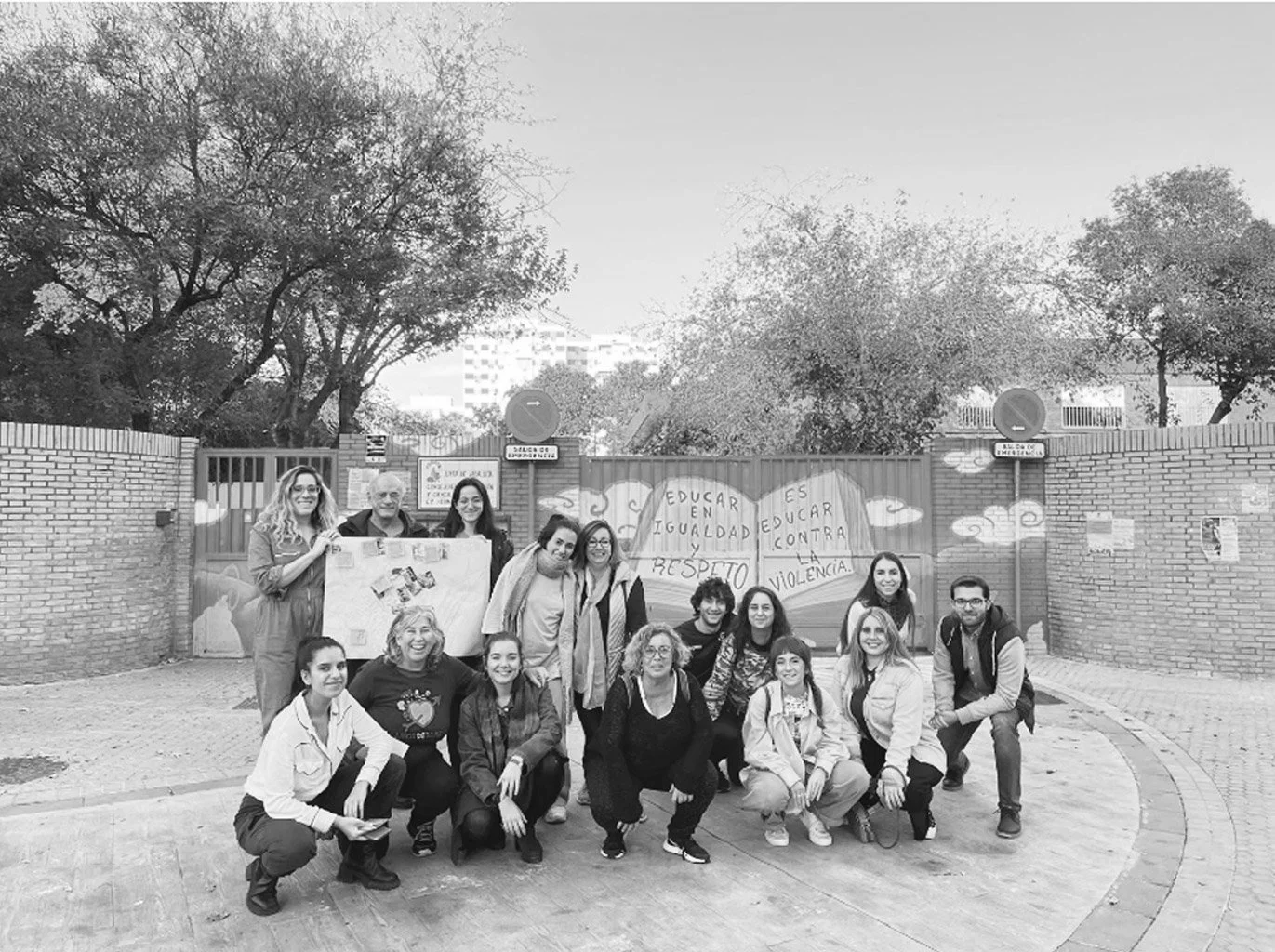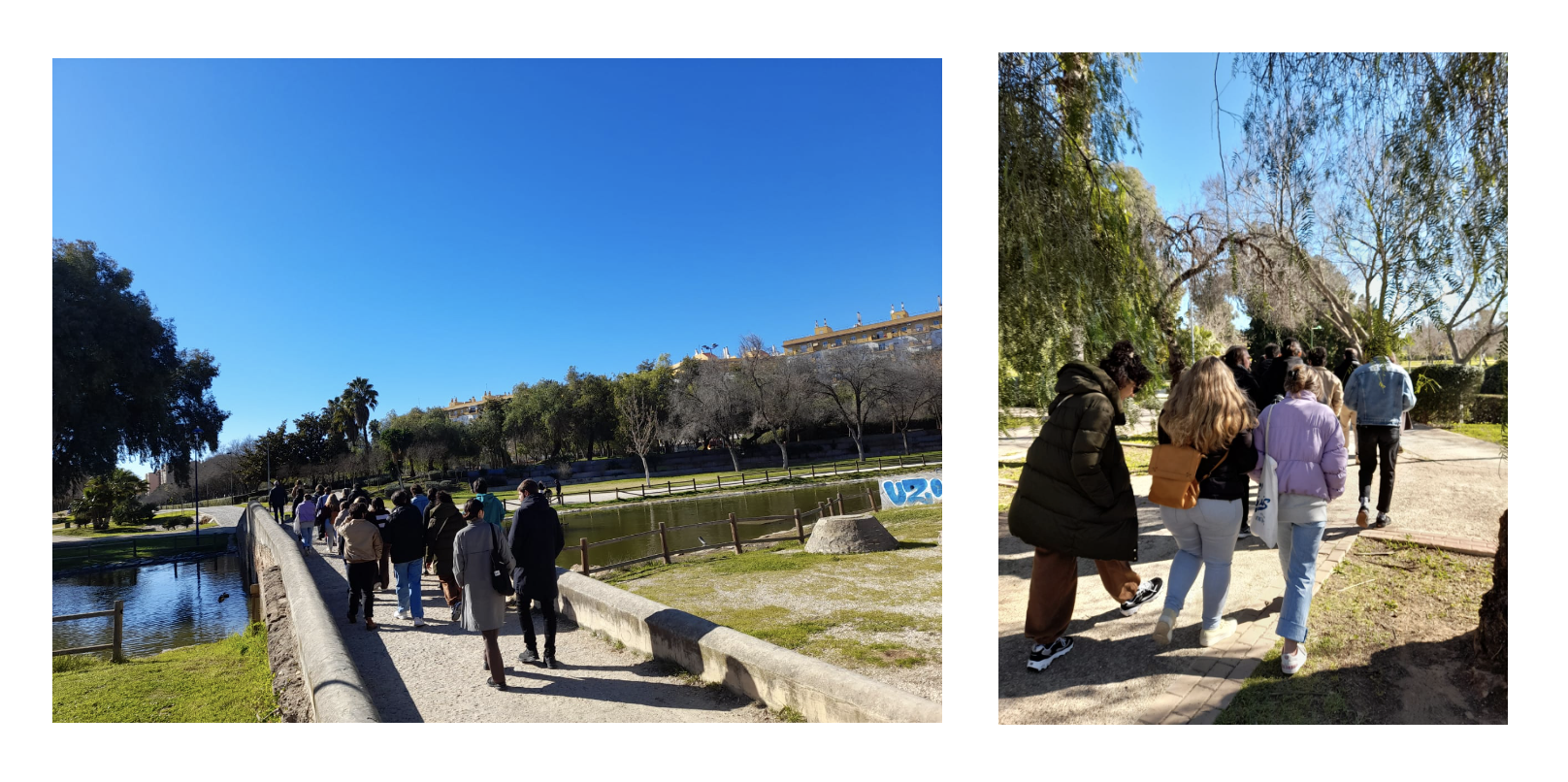Urban Exploration of San Diego, Seville
The UrbEX Local Labs in Seville took place between the 20th of November 2022 and 23rd of February 2023. In order to develop the Local labs, Zemos98 have been working together with La Digitalizadora and the Student’s Fathers and Mothers Association (AMPA) of CEIP Hnos. Machado.
Visiting the history of the neighboUrhood on its Anniversary
During the years 2020 and 2021, La Digitalizadora de la Memoria Colectiva carried out a project for the recovery of audiovisual historical memory of the daily life and neighbourhood struggles of the neighbourhood of San Diego and Los Carteros, a peripheral area in the city of Seville of working-class tradition, and whose history of self-management and impetus for the defence of a better life through their neighbourhood, has been ignored by the capital. The project was called SAN DIEGO, MEMORIAS DE LA PERIFERIA URBANA, and was funded through the ICAS project bank. It worked with the active participation of the entire San Diego neighbourhood, thanks to the mediation of the Andalucía Neighbourhood Association. As a result of this work, a collection was generated with all the digitized memories, containing videos, graphic material, photographs and documents. It was celebrated and disseminated in an outdoor projection in the neighbourhood square, where derivative works could be seen, produced by La Digitalizadora, which contextualize this archival material, and in a very accessible way, placed it in the present, and with the voice of its protagonists.
In the year 2023, the neighbourhood celebrates its 50th Anniversary, and the members of the AMPA of the school CEIP Hermanos Machado have contacted La Digitalizadora to organise activities around the memory of the neighbourhood and the centre itself. Given the need to return to the memory of the neighbourhood and to reactivate the archive generated by La Digitalizadora, UrbEX was proposed as a methodological creation project for the fulfilment of the objectives of the neighbours of the neighbourhood, through citizen participation, with the mediation of the teachers of the centre and the Andalusia Neighbourhood Association.
Methodology
Our Neighbourhood, 40 years later: Among the archives digitized during the project of La Digitalizadora, the following document of neighbourhood recognition and comparative study, carried out by the students of the school Hnos. Machado in 1980, appeared. It contains results of surveys, mapping, interviews and conclusions that gave the participants a great sense of class in relation to the urban periphery: Our Neighborhood (1980)
The study and possible replication of the methodology explained in this file could be a starting point for generational exchange. The former students would be able to explain this methodology used by the current students and a series of joint sessions would be developed with a methodology of the educational experience of neighbourhood recognition.
Our workshops
Zemos98 team and La Digitalizadora met at the request of the AMPA for the celebration of the 50th Anniversary. La Digitalizadora has a work of contact and mediation already done in the neighbourhood in previous years and now returns the proposal of collaboration for the celebration of the 50th Anniversary. UrbEX experiences were proposed as part of this celebration. Thus, together they agreed on embedding the project together with the Edu-City project, framed in the celebration of the 50th Anniversary of the neighbourhood (2023). In order to design the activities, the team used the historical archive of the neighbourhood as a guiding element.
Are you interested in our learning outcomes and materials? You are always welcome to get in touch or subscribe to our newsletter to get news about publications and events in your inbox.
Memory Route
The first workshop Zemos98 implemented in Seville took place on the 20th of November. A group of 20 old photographs of the neighbourhood digitized by La Digitalizadora de la Memoria Colectiva were converted into QR codes and printed as stickers to be placed in the streets of the neighbourhood. In an intergenerational encounter, the young people discussed the photographs with the elders of the neighbourhood, getting to know the neighbourhood's history.
They identified each photo with each QR sticker. They saw the images, talked about them, and on a map of the neighbourhood printed on A2, they placed each photograph in the place where it was taken, generating a route in which we will go through all those places, painting with markers on the map and sticking with post-its the numbers of the photographs.
Then, the group went out to make the route with our photographs already planned, and all together they were walking through the streets of the neighbourhood carrying the map in A2. The route ended at the school, a symbol of union among the participants.
Neighbourhood stories that make possible new forms of coexistence
The second workshop happened at Asociación de Vecinos Andalucía on the 28th of January 2023. The day started with the presentation of the participants by re-knowing ourselves through our neighbourhood memory. It was followed by a talk on "Neighborhood movements in the urban periphery" with Asarvahás, discussing topics such as: Why is San Diego a neighbourhood that has hosted numerous neighbourhood movements? What changes have the participants perceived in the last few years? What are the spaces in which they develop their activities and the transformation capacity of these activities? What ingredients does a neighbourhood need to favour coexistence?
Focusing on this last question and taking into account the comments made during the talk, the group wrote down the conditions that are considered essential for the emergence and considered essential for the emergence and implementation of neighbourhood activities, socio-cultural movements and and implementation of forms of coexistence.
In a cartography of the neighbourhood, the participants drew together the "more and less friendly areas of the neighbourhood", designing a route for the next activity: a walk "The real estate developer of urban coexistence"🔎.
Accompanied by the exploration sheets, they visited some of the scenarios of the documentary and other enclaves in San Diego in search of memories, spaces, or elements related to forms of coexistence as well as transformative alternatives (such as eliminating barriers in green areas to integrate the neighbourhood's gardens into daily activities, some spaces that have been abandoned by the city hall and they want back as a gardening learning space, etc…) to promote other ways of being together.
Fanzine
After having some meetings with the different stakeholders, there was a group of old students of the school CEIP Hnos Machado in order to create a fanzine that was an annex for this survey carried out by students 40 years ago. In the fanzine, we analyzed the materials digitized and discussed, in order to create different routes; one that could guide someone around the memory of the neighborhood; and another one that someone would do today to get all the good things from it.
Using an A2 map and different colors, the main stops were identified to make both routes, and after having the working session indoors, the participants went out to follow their own route, making a stop on each stop to gather information and contents related.
During the exploration and testing of the route provided, the participants made audio recordings in which they told the story of that specific spot and also claimed some demands related to that stop. They also took some pictures with a disposable camera and some videos with a digital one. All these materials were gathered to make the fanzine also a digital resource, almost like an audio guide of the neighborhood, but with a content developed by young neighbors that are demanding old ways of connecting, coexisting, and public spaces management.
After the collective walk the work continued in the indoors space to share some of the impressions, for example, the success of the audio recorder as a tool to explore the city. There was a discussion on who should this tour be introduced to and how the fanzine was going to be disseminated. The participants developed a strategy to share the final version of the fanzine on the mailboxes of their friends and neighbors. They wanted it to be disseminated not in the neighborhood itself, but also outside of it, so people around the city of Sevilla could also change their perspective of San Diego and could be encouraged to visit it and occupy the public spaces.





